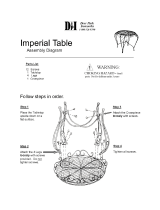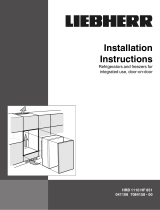
Contents
1 General safety information................................... 2
2 Putting into operation............................................ 2
2.1 Installing the appliance............................................. 2
2.2 Changing over door hinges...................................... 3
2.3 Built-in...................................................................... 4
2.4 Connecting the appliance......................................... 8
The manufacturer works constantly on the further development
of all the types and models. Therefore please understand that
we have to reserve the right to make design, equipment and
technical modifications.
To get to know all the benefits of your new appliance, please
read the information contained in these instructions carefully.
The instructions apply to several models. Differences may
occur. Text relating only to specific appliances is marked with
an asterisk (*).
Instructions for action are marked with a , the results of
action are marked with a .
1 General safety information
DANGER identifies a situation involving direct
danger which, if not obviated, may
result in death or severe bodily
injury.
WARNING identifies a dangerous situation
which, if not obviated, may result in
death or severe bodily injury.
CAUTION identifies a dangerous situation
which, if not obviated, may result in
minor or medium bodily injury.
NOTICE identifies a dangerous situation
which, if not obviated, may result in
damage to property.
Note identifies useful information and tips.
It is important that the procedures and directions given in these
instructions are complied with in order that the appliance is
correctly installed and works properly. Read and grasp all the
information in these instructions before the appliance is
installed.
2 Putting into operation
2.1 Installing the appliance
WARNING
Risk of fire due to short circuit!
If the mains cable/connector of the appliance or of another
appliance touch the rear of the appliance, the mains cable/
connector may be damaged by the appliance vibrations,
leading to a short circuit.
u
Stand the appliance so that it is not touched by connectors
or main cables.
u
Do not plug the appliance or any others into sockets located
near the rear of the appliance.
WARNING
Fire hazard due to dampness!
If live parts or the mains lead become damp this may cause
short circuits.
u
The appliance is designed for use in enclosed areas. Do not
operate the appliance outdoors or in areas where it is
exposed to splash water or damp conditions.
u
Only use the appliance when it is installed.
WARNING
Fire hazard due to refrigerant!
The refrigerant R 600a is environmentally friendly but flam-
mable. Escaping refrigerant may ignite.
u
Do not damage the piping of the refrigeration circuit.
WARNING
Fire hazard and danger of damage!
u
Do not place appliances emitting heat e.g. microwaves,
toasters etc. on the appliance!
WARNING
Blocked ventilation openings pose a risk of fire and damage!
u
Always keep the ventilation openings clear. Always ensure
that the appliance is properly ventilated!
q
In the event that the appliance is damaged, contact the
supplier immediately before connecting to the mains.
q
The floor at the site must be flat and level.
q
Do not install the appliance in a location where it is exposed
to direct radiation of the sun, next to a cooker, heater and
similar.
q
The appliance is suitable for integrated, under-worktop use.
q
Ventilation is effected by way of the plinth.
q
Do not install the appliance without assistance.
q
Standard EN 378 specifies that the room in which you install
your appliance must have a volume of 1 m
2
per 8 g of R
600a refrigerant used in the appliance. If the room in which
the appliance is installed is too small, a flammable gas-air
mixture may form in the event of a leakage in the refrigera-
tion circuit. The quantity of refrigerant used in your appliance
is indicated on the type plate on the inside of the appliance.
u
Detach the connecting cable from the rear of the appliance,
removing the cable holder at the same time because other-
wise there will be vibratory noise!
After installation:
u
Remove the protective film from the decorative trims.*
u
Remove all transit supports.
u
Unscrew the red transport
lock. Close the vacated
retaining hole using the
stopper (60).
u
Dispose of packaging material.
For Side-by-Side installation, freezer and refrigerator side by
side:
u
Always install the freezer on the right of the refrigerator, as
seen from the front.
w
No condensate forms between the appliances thanks to the
side wall heating system foamed in on the left.
Note
u
Clean the appliance .
General safety information
2









